The Centers for Medicare & Medicaid Services (CMS) has provided some guidance within the “Medicare and Medicaid Programs Policy and Regulatory Revisions in Response to the COVID-19 Public Health Emergency” interim final rule (IFR), allowing for remote patient monitoring, or RPM.
This type of patient care is very helpful for ongoing treatment during the COVID-19 pandemic, as it allows clinicians to remotely monitor temperature and pulmonary function, blood pressure, and other appropriate physiology for changes in a patient’s disease and symptom progression, using digitally connected, non-invasive devices (e.g. sensors for body temperature or thermometers, pulse-oximeters, and home blood pressure monitors).
Many COVID-19 patients can remain at home during treatment and recovery with the monitoring of their vitals, including breathing via pulse oximetry. Checking on a patient’s breathing is an important task related to treatment of the virus. The World Health Organization (WHO) indicates that the onset of severe pneumonia in adolescents or adults occurs when SpO2 is less than or equal to 93 percent. Patients are able to monitor their SpO2 at home via RPM, which can better monitor for that approaching target, rather than trying to decide what “difficulty breathing” entails.
Some RPM devices are equipped with a cellular blood pressure cuff, cellular weight scale, and a wireless pulse oximeterthat accurately measures blood oxygen level, pulse rate, and perfusion index. Originally created to help with chronic care patient monitoring, there are specific Current Procedure Terminology (CPT) codes for RPM.
CPT© codes for the provision of RPM include:
- CPT Code 99453: Remote monitoring of physiologic parameter(s) (e.g., weight, blood pressure, pulse oximetry, respiratory flow rate), plus initial set-up and patient education on use of equipment. (Initial set-up and patient education of monitoring equipment included; do not report 99453 for monitoring of less than 16 days.)
- CPT Code 99454: Device(s) supply with daily recording(s) or programmed alert(s) transmission, each 30 days. (Initial collection, transmission, and report/summary services to the clinician managing the patient.)
- CPT Code 99457: Remote physiologic monitoring treatment management services, clinical staff/physician/other qualified healthcare professional time in a calendar month, requiring interactive communication with the patient/caregiver during the month; first 20 minutes.
- CPT Code 99458: Each additional 20 minutes (List separately in addition to code for primary procedure.)
- CPT Code 99091: Collection and interpretation of physiologic data (e.g., ECG, blood pressure, glucose monitoring), digitally stored and/or transmitted by the patient and/or caregiver to the physician or other qualified healthcare professional, qualified by education, training, licensure/ regulation (when applicable) requiring a minimum of 30 minutes of time, each 30 days.
When a code has a description that includes “time,” that is a red flag, and a reminder to be sure the provider documentation has that component included in the visit note (documented). CMS does provide reimbursement for code 99453 (approx. $20), which is for the initial set-up and patient education on how to use the monitoring equipment. Reimbursement is also provided for CPT code 99454 (approx. $64), which is for supplying the device over a 30-day period.
Note that per the April 30 IFR, CMS will allow remote physiologic monitoring services to be reported to Medicare for periods of time of fewer than 16 days, but no less than two days, during the public health emergency (PHE). For monitoring of less than 16 days, but more than two days, payment for CPT codes 99453, 99454, 99091, 99457 and 99458 is limited to patients who have a suspected or confirmed diagnosis of COVID-19.
Remember that medical necessity will be critical for coverage of RPM, although CMS has not issued any specific guidance with regard to RPM. But in general, medical necessity means assigning the correct ICD-10-CM code (diagnosis). Also, it is important to obtain “advance patient consent:” practitioners must obtain permission for the service from the patient and document in the patient’s record. The justification for RPM should also be documented in the medical record in order to be compliant.
Certainly, RPM will be another area for auditing and education in the upcoming weeks and months.
——————————————————
Photo courtesy of: ICD10 Monitor
Originally Published On: ICD10 Monitor
Follow Medical Coding Pro on Twitter: www.Twitter.com/CodingPro1
Like Us On Facebook: www.Facebook.com/MedicalCodingPro







